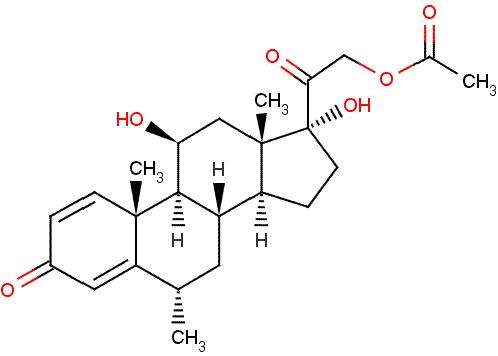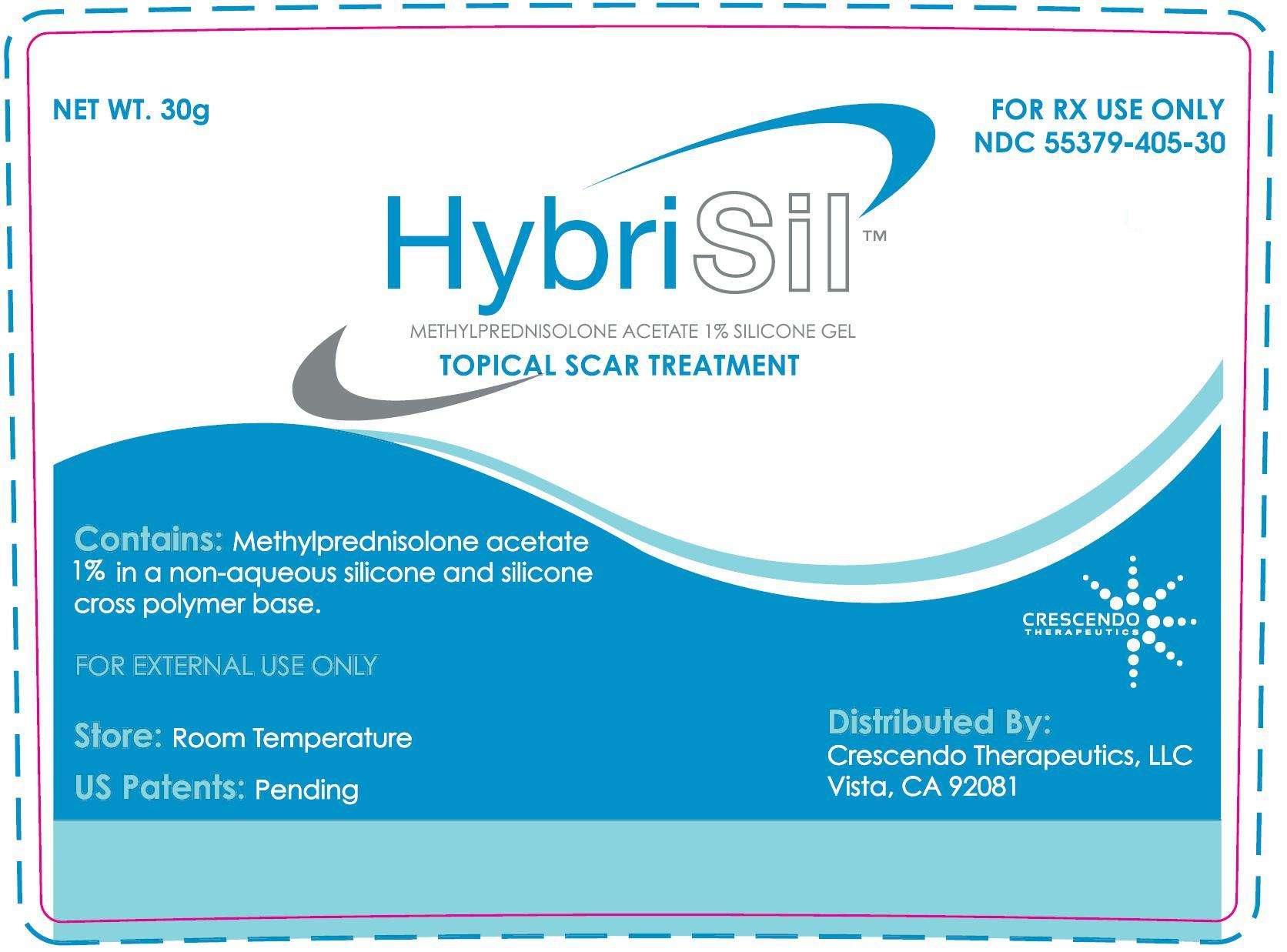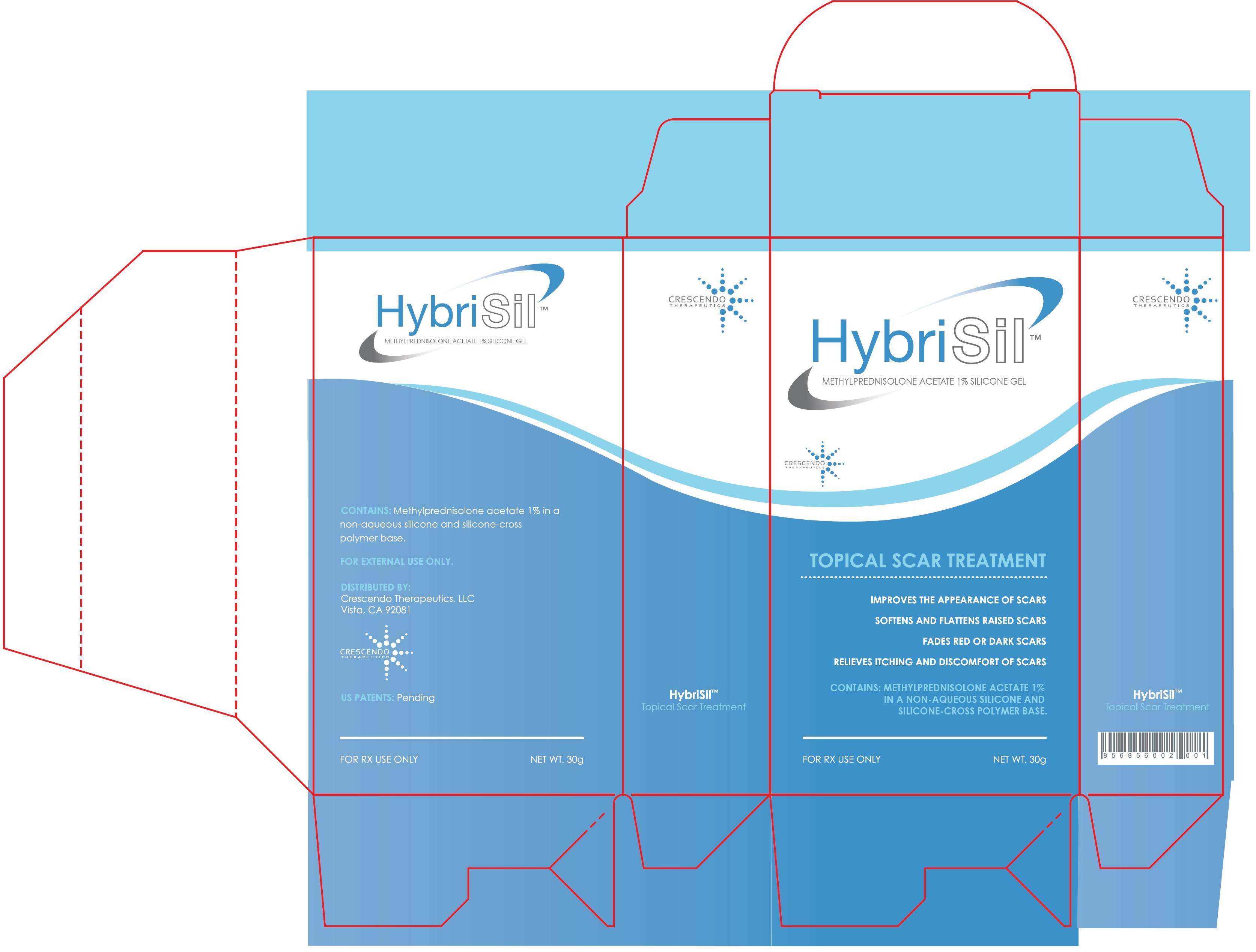Hybrisil
FULL PRESCRIBING INFORMATION: CONTENTS*
- HYBRISIL DESCRIPTION
- CLINICAL PHARMACOLOGY
- Pharmacokinetics
- HYBRISIL INDICATIONS AND USAGE
- HYBRISIL CONTRAINDICATIONS
- PRECAUTIONS
- Information for the Patient
- Laboratory Tests
- Carcinogenesis, Mutagenesis, Impairment of Fertility
- Pregnancy Category C
- Nursing Mothers
- Pediatric Use
- Side Effects
- Overdosage
- HYBRISIL DOSAGE AND ADMINISTRATION
- CAUTION
- HOW SUPPLIED
FULL PRESCRIBING INFORMATION
HYBRISIL DESCRIPTION
DESCRIPTION: The topical corticosteroids constitute a class of primary synthetic steroids used as anti-inflammatory and anti-pruritic agents. HybriSil™ Topical Silicone Gel contains methylprednisolone acetate, USP (CAS 53-36-1)
Chemical Name: Pregna-1,4-diene-3,20-dione, 21-(acetyloxy)-11,17-dihydroxy-6-methyl-,(6α,11ß)-,11ß,17,21-Trihydroxy-6α-methylpregna-1,4-diene-3,20-dione 21-acetate. It has a molecular formula of C24H32O6 and a molecular weight of 416.51.

Contains: Methylprednisolone acetate 1.0% in a base of: silicone cross-polymers, alcohol, cyclomethicones, propylene glycol, PEG-12 glyceryl dimyristate, and benzyl alcohol.
CLINICAL PHARMACOLOGY
Pharmacokinetics
The extent of percutaneous absorption of topical corticosteroids is determined by many factors including the vehicle, the integrity of the epidermal barrier and the use of occlusive dressings.
Topical corticosteroids can be absorbed from normal intact skin. Inflammation and /or other diseases processes in the skin increase percutaneous absorption. Occlusive dressings substantially increase the percutaneous absorption of topical corticosteroids. Thus, occlusive dressings may be a valuable therapeutic adjunct for treatment of resistant dermatoses. (see DOSAGE AND ADMINISTRATION)
Once absorbed through the skin, topical corticosteroids are handled through pharmacokinetic pathways similar to systemically administered corticosteroids. Corticosteroids are bound to plasma proteins in varying degrees. Corticosteroids are metabolized primarily in the liver and are then excreted by the kidneys. Some of the topical corticosteroids and their metabolites are also excreted into the bile.
HYBRISIL INDICATIONS AND USAGE
HybriSil™ topical gel is indicated for the relief of the inflammatory and pruritic manifestations of corticosteroid responsive dermatoses, including those associated with the formation of scar tissue.
HYBRISIL CONTRAINDICATIONS
Topical corticosteroids are contraindicated in those patients with a history of hypersensitivity to any of the components of the preparation.
PRECAUTIONS
General: Systemic absorption of topical corticosteroids has produced reversible hypothalamic-pituitary-adrenal (HPA) axis suppression, manifestations of Cushing’s syndrome, hyperglycemia and glucosuria in some patients.
Conditions which augment systemic absorption include the application of more potent steroid use over large surface areas, prolonged use and addition of occlusive dressings.
Therefore, patients receiving a large dose of a potent topical steroid applied to a large surface area or under an occlusive dressing should be evaluated periodically for evidence of HPA axis suppression by using the urinary free cortisol and ACTH stimulation tests. If HPA axis suppression is noted, an attempt should be made to withdraw the drug, to reduce the frequency of applications, or to substitute a less potent steroid.
Recovery of HPA axis function is generally prompt and complete upon discontinuation of the drug. Infrequently, signs and symptoms of steroid withdrawal may occur, requiring supplemental systemic corticosteroids.
Children may absorb proportionately larger amounts of topical corticosteroids and thus be more susceptible to systemic toxicity. (See PRECAUTIONS-Pediatric Use)
This medication contains alcohol. It may produce irritation or burning sensations on open lesions. If irritation develops, topical corticosteroids should be discontinued and appropriate therapy instituted.
As with any topical corticosteroid product, prolonged use may produce atrophy of the skin and subcutaneous tissues. When used on intertriginous or flexor areas, or on the face, this may occur even with short-term use.
In the presence of dermatological infections, the use of an appropriate antifungal or antibacterial agent should be instituted. If a favorable response does not occur promptly, the corticosteroid should be discontinued until the infection has been adequately controlled.
Information for the Patient
Patients using topical corticosteroids should receive the following information and instructions:
1. This medication is to be used as directed by the physician. It is for external use only. Avoid contact with the eyes.
2. Patients should be advised not to use this medication for any disorder other than for which it is prescribed.
3. Treated skin areas should not be bandaged or otherwise covered or wrapped as to be occlusive unless directed by the physician.
4. Patients should report any signs of local adverse reactions, especially under occlusive dressing.
5. Parents of pediatric patients should be advised not to use tight-fitting diapers or plastic pants on a child being treated in the diaper area as these garments may constitute occlusive dressings.
Laboratory Tests
The urinary free cortisol test and the ACTH suppression test may be helpful in evaluating the HPA axis suppression.
Carcinogenesis, Mutagenesis, Impairment of Fertility
Long-term animal studies have not been performed to evaluate the carcinogenic potential of the effect of topical corticosteroids on fertility.
Studies to determine mutagenicity with prednisolone and hydrocortisone may have revealed negative results.
Pregnancy Category C
Corticosteroids are generally teratogenic in laboratory animals when administered systemically at relatively low dosage levels. The more potent corticosteroids have been shown to be teratogenic after dermal application in laboratory animals. There are no adequate and well-controlled studies in pregnant women on teratogenic effects from topically applied corticosteroids. Therefore, topical corticosteroids should be used during pregnancy only if the potential benefit justifies the potential risk to the fetus. Drugs of this class should not be used extensively on pregnant patients in large amounts or for prolonged periods of time.
Nursing Mothers
It is not known whether topical administration of corticosteroids could result in sufficient systemic absorption to produce detectable quantities in breast milk. Systemically administered corticosteroids are secreted into breast milk in quantities not likely to have a deleterious effect on the infant. Nevertheless, caution should be exercised when topical corticosteroids are administered to nursing women.
Pediatric Use
Pediatric patients may demonstrate greater susceptibility to topical corticosteroid-induced HPA axis suppression and Cushing’s syndrome than mature patients because of a larger skin surface area to body weight ratio. Hypothalamic-pituitary-adrenal (HPA) axis suppression, Cushing’s syndrome and intracranial hypertension have been reported in children receiving topical corticosteroids. Manifestations of adrenal suppression in children include linear growth retardation, delayed weight gain, low plasma cortisol levels and absence of response to ACTH stimulation. Manifestation of intracranial hypertension include bulging fontanelles, headaches and bilateral papilledema.
Administration of topical corticosteroids to children should be limited to the least amount compatible with an effective therapeutic regimen. Chronic corticosteroid therapy may interfere with the growth and development of children.
Side Effects
The following local adverse reactions are reported infrequently with topical corticosteroids but may occur more frequently with the use of occlusive dressings. These reactions are listed in an approximate decreasing order of occurrence:
Burning, Itching, Irritation, Dryness, Folliculitis, Hypertrichosis, Acneiform eruptions, Hypopigmentation, Perioral dermatitis, Allergic contract dermatitis, Maceration of the skin, Secondary infection, Skin atrophy, Striae and Miliaria.
Overdosage
topically applied corticosteroids can be absorbed in sufficient amounts to produce systemic effects (see PRECAUTIONS)
HYBRISIL DOSAGE AND ADMINISTRATION
HybriSil™ (methylprednisolone acetate 1%) silicone gel should be applied to the affected area as a thin film two or three times daily depending on the severity of the condition.
Occlusive dressings may be used for management of recalcitrant conditions. If an infection develops, the use of occlusive dressings should be discontinued and appropriate antimicrobial therapy instituted.
CAUTION
If medication accidentally gets in the eyes, wash thoroughly with water and contact a physician immediately. Keep out of the reach of children.
HOW SUPPLIED
in 30 gm bottle with pump. Prescription only.
US Patents: Pending.
Revised April 2011
Image: Bottle Label
label_cd01.jpg

Image: Carton Label
uc_CD01.jpg

HybrisilMethylprednisolone Acetate GEL
| ||||||||||||||||||||||||||||||||||||||||||||||||||||||